Bed Bugs
ENTFACT-636: Bed Bugs | Download PDF | En Español
by Michael F. Potter, Extension Entomologist
University of Kentucky College of Agriculture
Bed bugs have made a major comeback in the U.S. and around the world. The public experienced a reprieve from the pests after World War II, due in part to the widespread use of DDT. The rebound in recent years was probably due to multiple factors, including less potent insecticides, global travel, and a loss of vigilance practiced in years past. Whatever the reasons, bed bugs are again part of everyday life, with infestations common in homes, apartments, hotels, dormitories, schools and shelters. They also occur in hospitals, nursing homes, libraries, theaters, offices, municipal buildings, and on public transportation— wherever there are people there can be bed bugs.
Bed Bug Basics
Bed bugs are small, brownish insects that feed solely on the blood of animals. Although the common bed bug (Cimex lectularius) prefers feeding on humans, it will also bite other warm-blooded animals, including dogs, cats, birds and rodents. It has done so since ancient times; bed bugs are mentioned in medieval European texts and classical Greek writings back to the time of Aristotle.

Bed bugs depicted in a book published in 1485.
Adult bed bugs are about 3/16-inch long and reddish-brown, with oval, flattened bodies. Their coloration is similar to an apple seed although their size is closer to a lentil. The bugs are sometimes mistaken for ticks, cockroaches, carpet beetles or other household insects. Immature bed bugs (nymphs) resemble the adults, but are smaller and lighter in color. Bed bugs don’t fly, or jump like fleas, but can crawl rapidly over floors, walls, ceilings and other surfaces.
Adult females lay their eggs in secluded places, depositing one, two or more per day, potentially hundreds during their lifetime. The eggs are tiny (about the size of a dust spec), whitish and hard to see without magnification, especially on light-colored materials. When first laid, eggs are sticky, causing them to adhere to surfaces. At room temperature, bed bug eggs hatch in about a week. The newly emerged nymphs are straw-colored and no bigger than a pinhead. As the nymphs grow, they molt, shedding their skin five times before reaching maturity. A blood meal is needed between each successive molt. Adult females must also periodically feed in order to lay eggs. Under favorable conditions (70-80°F) and a ready supply of blood, the bugs can mature in as little as a month and produce multiple generations per year. Cooler temperatures or limited access to a host prolongs development. Given adequate resources, the average lifespan of a bed bug is about 10 months.

Adults, nymphs, eggs, shed skins, and fecal spots on a mattress.
Bed bugs are resilient. Nymphs and adults can persist months without feeding which is unusual for most insects. The ability to survive without a blood meal is longer at cooler temperatures ― potentially up to a year or longer at 55°F or less. In temperature-controlled buildings, a more typical duration without feeding is about 1 to 4 months. Consequently, it is usually impractical to leave homes unoccupied in hopes of ‘starving’ an infestation. When infested dwellings such as apartments are vacant, bed bugs often disperse to nearby units, or reduce their activity until the unit is reoccupied.
Bed bugs are active mainly at night. During the day, they tend to hide close to where people sleep. Bed bugs prefer to hide close to where they feed, but if necessary will crawl longer distances in search of a meal. Initially they tend to be concentrated around beds, sofas, and other sleeping and resting areas—but if infestations are allowed to persist, they may disperse elsewhere making elimination more difficult.
Their flattened bodies enable them to fit into tiny crevices no wider than a toothpick. Bed bugs don’t have ‘nests’ like ants or bees, but do tend to congregate in habitual hiding places like mattresses, box springs, bed frames and headboards. Characteristically, these areas are marked by dark spotting and staining, which is the dried excrement of the bugs. Also present will be hatched and unhatched eggs, and tan-colored ‘skins’ shed by developing nymphs. Another possible sign are rusty or reddish smears on bed sheets or mattresses from blood-engorged bed bugs that have been crushed. Although it’s often stated that bed bugs have a telltale “buggy” odor, the smell is seldom apparent except in extreme infestations and should not be relied upon for detection.

Dark spots on mattress and box spring are a telltale sign of bed bugs, occasionally accompanied by reddish smears or stains.
Bites and Health Concerns
Bed bugs usually bite people at night while they are sleeping. Hungry bed bugs may also feed during the day, especially if this is when the occupant normally sleeps. They feed by piercing the skin with an elongated beak through which they withdraw blood. Engorgement takes about three to 10 minutes, but because the bite is painless, people seldom realize they are being bitten. Bed bugs normally do not reside on or attach to people like lice or ticks; immediately after feeding they crawl to a secluded location to digest their meal.
Symptoms after being bitten by bed bugs vary from person to person. Many develop an itchy red welt within a day or so of the bite. Others have little or no reaction. Sometimes the reaction is delayed days or even weeks, which can make it difficult to determine where or when bites actually occurred. Studies conducted in bed bug-infested apartments suggest about 30 percent of people do not react even when bitten repeatedly, and even higher levels of non-reactivity occur among the elderly. Unlike fleabites, which occur mainly around the ankles, bed bugs feed on any skin exposed while sleeping (face, neck, shoulders, back, arms, legs, etc.).
The welts and itching are often wrongly attributed to other causes, such as mosquitoes. As such, infestations may go a long time unnoticed, and can become large before being detected. The likelihood of bed bug involvement increases if the affected individual has been traveling, or had acquired used beds/furnishings before symptoms started to appear. Bed bugs also are suspect if you wake up with itchy welts you did not have when you went to sleep. Conversely, it’s important to recognize that not all bite-like reactions are due to bed bugs. Confirmation requires finding the bugs and/or their signs, which often requires a professional. (Other possible sources of irritation that may be mistaken for bed bugs are discussed in University of Kentucky entomology publication ENTFACT-649, MYSTERY BITES: Insect and Non-Insect Causes.)
A common concern with bed bugs is whether they transmit diseases. Although the bugs can harbor various pathogens, transmission to humans has not been proven and is considered unlikely. Their medical significance is mainly attributed to itching and inflammation from their bites. Antihistamines and corticosteroids may be prescribed to reduce allergic reactions, and antiseptic or antibiotic ointments to prevent infection. Though not known to transmit diseases, bed bugs can reduce quality of life by causing discomfort, sleeplessness, anxiety, and embarrassment. According to some health experts, the added stress from living with bed bugs can have a significant impact on the emotional health and well-being of certain individuals.
Insect repellents used to deter ticks and mosquitoes do not appear to be as effective against bed bugs, and applying them at bedtime is not recommended. Sleeping with the lights on is also not likely to deter hungry bed bugs, as they will adjust their feeding cycle to the host’s sleep patterns.
How Infestations Occur
It often seems that bed bugs arise from nowhere. The bugs are efficient hitchhikers and are easily transported into dwellings on luggage, clothing, beds, furniture, and belongings. This is a particular problem for hotels and apartments, where turnover of occupants is constant. Bed bugs are small and agile, avoiding detection by crawling into concealed locations. Acquiring secondhand beds and furniture is another way they can be transported into buildings. The bugs can also be inadvertently carried in on one’s clothing, shoes, wheelchair, etc.
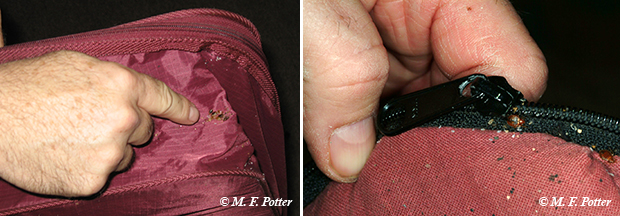
Bed bugs can be introduced on backpacks, luggage, and other belongings.
Once bed bugs are introduced, they can crawl from room to room, or floor to floor via cracks and openings in walls, floors and ceilings. They also can be transported throughout buildings by ‘hitching a ride’ on people and their belongings. Unlike cockroaches and flies that feed on filth, there is often no relationship between bed bugs and cleanliness. Since the bugs feed solely on blood, pristine dwellings can be as vulnerable to infestation as are places of squalor. Nonetheless, poverty and privation are often associated with persistent problems due to an inability to afford professional extermination.
Some bed bug species are parasites of bats or birds (e.g., swallows or chimney swifts), and may bite people, especially if the wild hosts are no longer present. Although similar in appearance, the species that normally feed on bats and birds can be differentiated from those that prefer humans. Entomologists and pest professionals can make this determination. If bat bugs or bird bugs are present, roosting and nesting sites should be the focus of treatment, combined with exclusion of the wild hosts.
Controlling Infestations
Bed bugs are challenging to eradicate. Since they can hide in so many places, inspections must be thorough and elimination is not always a certainty. When resources allow, it’s prudent to enlist the services of a professional. Experienced pest controllers know where to look for bed bugs and have an assortment of management tools at their disposal.
Where They Hide
Bed bugs can live in almost any crevice or protected location. The most common place to find them is beds or areas where people rest or sleep. This is especially true during the early stages of an infestation. As numbers grow larger, the bugs tend to move beyond beds into other locations, making control more difficult.

Bed bugs most often congregate along seams and edges of mattresses and box springs. Blackish spots are excrement.
Bed bugs often hide in seams, folds and crevices of the mattress, box spring, bed frame and headboard. A thorough inspection requires dismantling the bed, and standing the components on edge so that upper and lower seams and surfaces can be examined. Things to look for are the bugs themselves, shed skins of the nymphs, and the blackish fecal spots. Dark spots of dried bed bug excrement are often present along mattress seams or wherever the bugs have resided.
Box springs afford many places for bed bugs to hide, especially along the upper seams and underneath, where the bottom edge of the box rests on the frame. If an underlying dust cover is present, it may have to be removed to gain access for inspection and possible treatment. Crevices of bed frames also should be examined, especially if the frame is wood. Bed bugs have an affinity for wood and fabric more so than metal or plastic. Wooden support boards, if present, should be removed and examined since bed bugs often congregate where the ends rest on the frame. Screw holes and other recesses are also common hiding places. Headboards affixed to walls should be removed and inspected. In hotels, the area behind the headboard is often the first place bed bugs become established. Bed bugs also frequently hide within items stored under beds.
Upholstered chairs, recliners and sofas are the next most likely areas for bed bugs, and should be examined carefully along seams, skirts and folds of fabric. Sofas and recliners can be major bed bug hotspots, especially when used for sleeping.
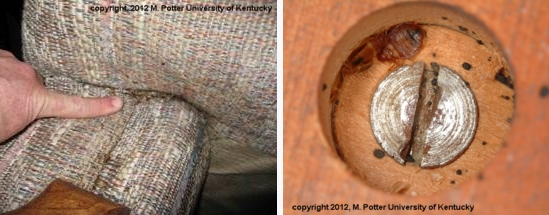
Bed bugs also congregate along seams of sofas and recliners. Photo at right shows
bugs hiding near a recessed screw under a nightstand (note the presence of fecal spots).
Nightstands and dressers may need to be emptied and examined inside and out, and tipped over to inspect the woodwork underneath. Oftentimes the bugs will be hiding in cracks, corners, and recesses. Other common bed bug hiding places include: along and under the edge of wall-to-wall carpeting, especially behind beds and sofas; cracks in wood molding; ceiling-wall junctures; behind wall-mounted pictures, mirrors, outlets and switch plates; under loose wallpaper; clothing and clutter in closets; along book bindings; and inside clocks, phones, televisions and smoke detectors.
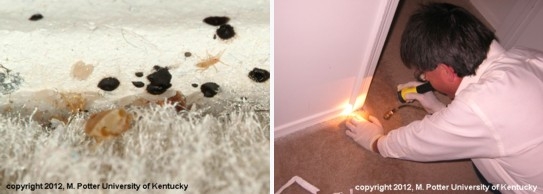
Bed bugs often reside along baseboards. Photo at left shows eggs, nymphs, adults and fecal spots near a carpet edge.
Bed bugs tend to congregate, but it’s also possible to find a single bug here and there. A thorough inspection and treatment may take up to several hours. Some companies use specially trained canines to help find small, dispersed infestations, especially in such places as hotels, libraries, offices, and theaters. When properly trained, bed bug detection dogs can be quite effective. Relatively few firms routinely use them, however, due to the expense of training and maintaining such animals. Reliability can also be an issue and may vary from one canine inspection to the next.
Cooperation is Important
Cooperation is important during bed bug treatment. Both owners and occupants will need to assist the pest controller to ensure a successful outcome. Since bed bugs are mobile and can disperse building-wide, it often is necessary to inspect additional rooms and apartments, especially around the one known to be infested. Affording access to bedrooms and living areas is crucial, and excess clutter may need to be eliminated. Belongings strewn about afford many places for the pests to hide, and may impede inspection and treatment.
Extensive preparation may be necessary when infestations are large and the bed bugs are dispersed. Conversely, little or no ‘prep’ may suffice for light infestations, given that in these cases the bugs are typically more confined to beds, sofas, etc. Pest managers have their own policies, however, in regards to preparation, which also may depend on the manner of treatment. Some firms want beds stripped and furniture moved before they arrive, while others, increasingly, prefer to inspect first and perform these tasks themselves. Clutter and belongings (especially under and around beds) often must be removed since it impedes treatment and affords additional places for bed bugs to hide. Housecleaning activities such as vacuuming floors and surfaces seldom reach areas where bed bugs reside. For this reason, many firms consider vacuuming by clients less crucial than other preparatory activities.
Laundering Items- Bedding and garments often will need to be laundered (120°F minimum) since they cannot be treated with insecticides. An effective and efficient alternative to laundering is to place bedding, clothing, toys, shoes, backpacks, etc., in a clothes dryer set at medium-to-high heat for 10 to 20 minutes; lethal temperatures will be achieved more quickly if items are initially dry. This can be done in lieu of washing and will kill all bed bug life stages. According to textile experts at the Drycleaning & Laundry Institute (Laurel, MD), most garments designated as ‘dry-clean only’ (e.g., cotton, wool, silk, linen, rayon, nylon) will not be harmed provided they are dry before being placed in a clothes dryer at a moderate temperature setting. Dry cleaning procedures also kill bed bugs, but there is a risk of infecting the establishment when buggy items are tagged and sorted. Placing items in disposable plastic trash bags helps to minimize the risk of bugs falling off in the dwelling during transfer to the washer and/or dryer.
Items that cannot be put in a washer or dryer can sometimes be de-infested by wrapping in plastic and placing them outdoors for at least a day in a hot, sunny location―such as on pavement, or inside a closed vehicle parked in the sun. Packing items loosely in black trash bags and elevating objects off the ground helps the heat permeate better, making it harder for bugs to find a cool spot to hide. Monitoring with a thermometer can help ensure that a temperature of at least 120°F is achieved wherever bugs may be present. Bed bugs also will succumb to cold temperatures below 32°F, but the freezing temperatures must be maintained for a much longer period, e.g., one to two weeks. Consequently, heating tends to be a better option. Efforts to rid dwellings of bed bugs by raising or lowering the thermostat will be unsuccessful, although professionals are able to achieve lethal temperatures with supplemental heaters (see subsequent section entitled “Heat Treatments” for details).
Discarding vs. Encasement - Mostbelongings need not be discarded, although at times this may be advisable. In cases where beds and upholstered items are heavily infested, the pests often reside in hard-to-reach places. If there are holes or tears in the fabric, bugs and eggs may be inside, as well as on the outer surface. When infested items are discarded, bagging or wrapping them in plastic prevents dislodgement of bed bugs en route to the curb or dumpster. Marking or defacing infested items discourages pickup by others and helps limit their spread.
In the case of beds, a more economical option is often to encase both the mattress and box spring in protective covers like those used for allergy relief. Encasements specifically designed to help protect against bed bugs are available through retailers or pest control firms. Higher quality encasements tend to be more durable and comfortable to sleep on. Once the covers are installed and zipped shut, any bed bugs that happen to be inside eventually die. Encasements also help protect newly purchased beds, and make it easier to spot and destroy any bugs residing on the outer surface during subsequent examination. However, encasements will not keep bed bugs from crawling onto a bed and biting a sleeping person. Bed bug-proof encasements are also available for sofas and loveseats and can be supplied by pest managers.

Encasements are an economical alternative to discarding infested beds.
Vacuuming, Steaming, Freezing
As mentioned earlier, household vacuuming of floors and surfaces seldom reaches the areas where bed bugs typically hide. Targeted vacuuming of infested locations, however, can help remove some of the pests before additional treatment is undertaken. Bed bugs and especially eggs can be difficult to dislodge. Optimum results are achieved by slowly scraping the end of the suction wand along infested seams, folds and edges of beds and upholstered furniture, perimeter edges of flooring, and wherever bugs are observed. Bed bugs can survive being sucked up by a vacuum, so it’s important to dispose of the contents in a sealed trash bag. To make disposal easier, a knee-high nylon stocking can be inserted (toe first), into the end of the suction wand, securing the other end of the stocking around the wand opening with a rubber band. When the bugs are sucked into the tube, they will be trapped in the stocking, which can be secured and discarded.
Some pest control firms also employ commercial steamers or spot-freezing equipment to treat areas where bed bugs are found or suspected. Used correctly, they kill bugs and eggs on contact. Neither method, however, affords residual protection against bed bugs that may have been missed. Steaming and spot-freezing equipment also have limited ability to penetrate fabric and other materials where bed bugs often reside. Consequently, the methods are seldom used alone, but in conjunction with other measures.
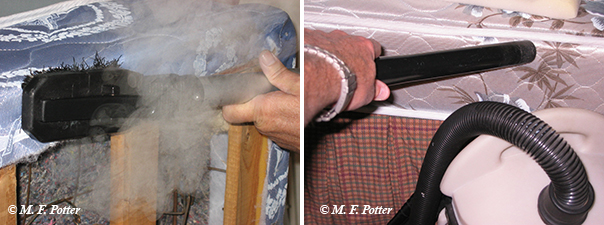
Steamers and vacuums can help eliminate infestations.
Heat Treatments
Some pest control firms use specialized heating equipment to de-infest furnishings, rooms, and entire dwellings of bed bugs. The procedure involves heating up the infested item or area to temperatures lethal to the bugs. Portable heaters and fans are used to gradually heat the air to about 120-130°F while monitoring with strategically placed sensors. By carefully controlling the temperature, bugs and eggs are killed wherever they may be without damaging household items.
While some preparation is still necessary, the amount of de-cluttering required with heat treatment is often less than with other approaches. Some heat-sensitive items such as aerosol cans, indoor plants, and medications will need to be removed, although televisions, computers, and other electronics usually do not. It’s also unnecessary to launder bedding and clothing since these items will be heated along with other belongings. Another advantage of heat treatment is that infestations can often be eliminated in one day, rather than over multiple days or weeks. Conversely, heat treatment alone has no lasting (residual) effect should bed bugs be reintroduced into the dwelling. Consequently, some firms concurrently apply insecticides. To further minimize reintroduction, occupants are advised to take as few belongings as possible with them while the heat up is performed. Heat treatments require special expertise and equipment, and may be more costly than conventional methods relying primarily on insecticides.
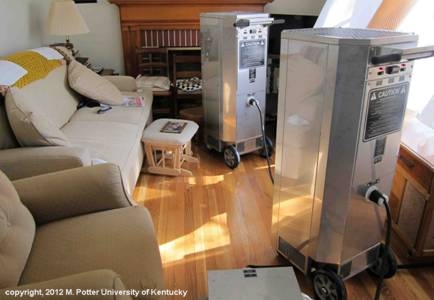
Heat treatments are an effective way to eliminate bed bugs quickly, but may be more costly than conventional treatment methods.
Insecticides
While the former measures are helpful, insecticides are also used by most professionals. A variety of products is available formulated as liquids, aerosols and dusts. Baits such as those used to control ants and cockroaches are ineffective since these bugs must bite and feed on blood. Bed bugs are becoming increasingly resistant to pesticides, similar to the way some germs have become resistant to antibiotics. Professionals know which products tend to be most effective. Application entails treating all areas where the bugs are found or likely to reside. This takes a good bit of effort, and follow-ups are usually needed. Companies often treat seams, folds and crevices of beds, chairs and sofas, but usually will not spray the sleep surface or seating area. They also do not spray bedding or clothing, which instead should be hot washed or heated in a dryer. Bleach, alcohol, cigarette lighters, and ‘bug bombs’ (foggers) should NOT be used to control bed bugs. These actions are ineffective and can result in fires and other dangerous outcomes.
Fumigation using a penetrating gas is another way to de-bug dwellings or furnishings, but certain companies only offer the procedure. True fumigation is not the same as setting off a fogger or bug bomb. The fumigation process is technically complex and requires vacating the building for a period of days. The building is then sealed and injected with a lethal gas, usually sulfuryl fluoride. Because the entire building must be vacated, the procedure is logistically more challenging with multi-unit properties such as apartments, than for single-family homes. Bed bug fumigations tend to be more common in southern and western states, where the approach is also used to control certain types of wood-dwelling termites.
Preventing Infestations
With all the effort and expense to eradicate bed bugs, it’s prudent to take precautions against contracting them in the first place. Avoid bringing discarded mattresses and sofas into the home, and closely examine any secondhand items for fecal spots and other telltale signs of bed bugs. There is no reason to stop shopping in consignment stores, yard sales, etc., but it’s wise to run clothing and fabrics through the washer or dryer before storing them in the home. The risk of picking up bed bugs from antique shops is insignificant.
Avoiding bed bugs is especially challenging in apartments, hotels, and other places where there are many people and opportunities for introduction. Pro-active surveillance by tenants, housekeepers, and pest managers is the best way to detect infestations in their initial stages when they are easiest to control. The longer bed bugs go undetected, the more likely they are to disperse to other locations besides sleeping and resting sites. In multi-occupancy buildings such as hotels and apartments, neglected infestations are also more likely to spread to other units. Since bed bugs are cryptic and nocturnal, visual inspection alone can fail to reveal their presence. Various devices are available to help monitor for bed bugs that may have been missed. Most popular are small plastic dishes (e.g., ClimbUp Insect Interceptors) that wandering bed bugs crawl or fall into but cannot escape due to the slippery inner surface. Some of these ‘pitfall-style’ traps have no attractant, while others emit a chemical scent. Typically, the devices are placed under the legs of beds and seating, or close by. Periodic checking by occupants or pest professionals can help to reveal bed bugs in the crucial early stages of infestation. They are also useful in determining whether an infestation has been eliminated.
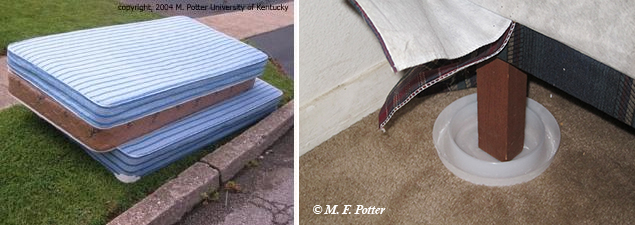
Discarded beds and couches might be infested and should be left alone. Dish-shaped traps placed under beds and sofas can help to reveal bed bugs and reduce bites.
Additional Tips for At-Risk Groups
Apartment Buildings
Multi-unit housing is one of the most challenging environments for bed bugs. Many people living in the same building increases the potential for the pests to enter, multiply, and spread. Apartments also tend to be smaller and more cluttered than single-family homes, which can hinder inspection and treatment. Another difficulty in apartment buildings is that bed bugs often go undetected and/or unreported by tenants. These unknown infested units become sources of spread throughout the building. Consequently, properties should not rely solely on tenant complaints to reveal infestations. It is important that they also employ routine, building-wide inspections (quarterly, semi-annually, etc.) by a professional. Since bed bugs often wander between apartments, it is vital to inspect units near those known or suspected of being infested — on either side, above, below, across the hall, etc. The reliability of such inspections can be enhanced further by installing dish- or dome-shaped pitfall-style traps (ClimbUp Insect Interceptors, BlackOut Bed Bug Detector, SenSci Volcano, etc.) near beds and seating areas. Such devices can help reveal presence of bugs in the important early stages of infestation, and between times when other inspections are performed. Most importantly, successful management of bed bugs in multi-unit housing requires honesty, openness, and collaboration between tenants, property managers, and their pest control contractor.
Business and Leisure Travelers
Checking your bed for bed bugs was a common practice years ago, especially when traveling. Today’s traveler should consider doing the same, preferably before unpacking. This would entail examining the bed sheets and seams of the mattress and perhaps box spring for signs of bed bugs, especially along the head (pillow end) of the bed. Some experts also make it a habit of removing and checking behind headboards since this is a frequent hiding place for the bugs in hotel rooms. Headboards are heavy and cumbersome, though, and untrained persons should not attempt removal themselves.
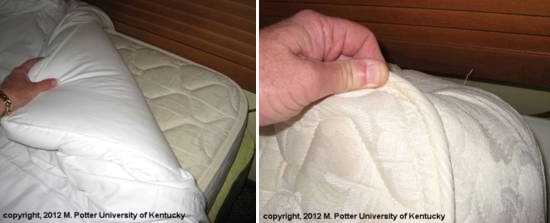
To help guard against bed bugs while traveling, take a moment to inspect beds. A flashlight is useful for dimly lit areas.
Vigilant travelers may also want to elevate luggage off the floor on a stand, table, or other hard surface rather than stowing it on the floor or another bed. Unpacking what’s necessary and retaining the rest in a zipped up suitcase might be prudent. Cautious individuals may even want to keep belongings in sealed plastic pouches or totes — each traveler must decide how vigilant they wish to be.
The majority of bed bug infestations in hotels are limited, oftentimes to just a few rooms. If bugs are discovered, guests can request another room, preferably in a different area of the hotel since infestations sometimes extend to nearby units. Should you experience itchy welts suggestive of bites during your stay, it would be prudent upon returning home to place all clothing directly into the washer/dryer. Inspecting or vacuuming suitcases is less useful since it is difficult to spot bed bugs in luggage. Suitcases in question can either be heat-treated (a hot car can often do the trick in summer) or discarded.
Social Service and Emergency Workers
Caregivers, firefighters, and other service providers are sometimes required to enter and assist in bed bug-infested dwellings. In doing so, there is the potential to transport the pests home or to the workplace. As noted earlier, bed bugs do not fly, or jump onto people and pets as fleas do. During the day, the bugs usually remain hidden, becoming more active at night when seeking a host. Consequently, the chance of picking up bed bugs by simply walking into an infested dwelling during the day is unlikely. The risk may increase while providing care but can be lessened by taking a few precautions.
Bring in only what is needed, and avoid sitting or placing coats and other items on beds, sofas and floors where the bugs often reside. Essential items can be placed on a table or other hard surface, preferably away from bedrooms and sleeping areas. It’s better to sit on a hard, non-upholstered chair than on sofas and recliners. Also, try to avoid leaning or brushing against beds and furniture. If such items are carried out of infested dwellings (e.g., by sanitation workers), it’s best to wrap them in plastic or at least not hold them against your body during transport. Emergency medical personnel may need to take additional precautions, such as removing/bagging a patient’s infested shoes or clothing, or installing plastic sheeting inside the emergency vehicle.
Although applying insect repellent at bedtime is not an effective way to deter bed bugs, there may be some benefit to spraying tops/bottoms of shoes with DEET-based repellents when working in severely infested dwellings. Those working in such environments may want to hot wash or run their clothing/shoes through a dryer upon returning home or to the office.
Schools and Daycares
Bed bugs are a growing problem in schools and day cares. Consequently, teachers, nurses, and administrators should be educated about the pests and their appearance. Typically, students or staff with an infestation at home introduce the bugs. Pinpointing where bed bugs might be located in a school setting can be challenging since there are no permanent sleeping areas where the pests can congregate. (Similar challenges occur when hunting bed bugs in offices, libraries, etc.) Incidents in schools often involve small numbers of bed bugs spotted on a student’s clothing, backpack, chair or desk. While this does not necessarily mean the pupil’s residence is infested, the parents should be advised to have the home inspected by a professional. Bed bugs should also be considered if a student often comes to school with itchy welts— but remember such reactions can be for reasons other than bed bugs.
Small numbers of bedbugs spotted in schools, libraries, offices, etc. necessitate action—but usually do not warrant closure or cessation of operations. In such locations where there are no beds or recurrent sleeping hosts, introductions of a few bed bugs are less likely to multiply and result in the type of infestations observed in homes and apartments. While it’s common to overreact in these situations, resources are better spent educating employees and following science-based protocols. Infested belongings should be bagged and run through a clothes dryer at school or at home. Inspection and targeted treatment (if necessary) should focus on chairs, couches, desks, lockers, coat closets, etc. Indiscriminate, prophylactic spraying of classrooms, hallways or buses is unnecessary, ineffective and imprudent.

Bed bug sightings in schools, offices, etc. seldom warrant closure or cessation of operations.
Healthcare Facilities
Bed bugs are becoming increasingly common in patient care facilities. The key to effective management is early detection and containment. This requires education and involvement of all staff including administration. The role of the pest control provider is important also, but no more so than that of hospital personnel. All employees should know what procedures to follow when they see or receive word of a possible bed bug incident. It helps to have an on-site coordinator to respond to incidents, including interviewing persons suspected of bringing in bugs and confirming that they are indeed bed bugs. Temporary isolation and containment of such people and their infested belongings is crucial to stemming building-wide occurrences. Some patient care facilities use clear plastic zip-lock bags or other tight-fitting containers to store personal belongings in examination or patient rooms.
If bugs are found in an examination, patient or waiting room, the room should be thoroughly inspected. While bed bug insecticides are not particularly hazardous, they should be used sparingly in health care settings. Spot killing of bed bugs on beds, sleep chairs, furniture or flooring often can be accomplished with disinfectants used for terminal cleaning. Vacuums and steamers also can be deployed against small numbers of bed bugs found in accessible locations. Infested beds and furniture should ideally be treated with heat in a designated area of the hospital. Care should be taken not to dislodge bed bugs during transit and it is often wise to wrap the items in plastic. Periodic, pro-active inspection of waiting rooms, lounges, sleep- study/dialysis clinics, etc. is advisable by in-house staff and their pest professional. Frequency of inspection should depend on the history of prior incidents and risk of future infestation. If there is reason to believe incoming patients, family members or visitors are harboring bed bugs, instructions may be given to remove belongings from the building and take them home to be laundered.
Office Buildings
Bed bugs also can be transported into the workplace. As with schools, libraries, etc. infestations in offices tend to be limited in scope and often confined to workstations and seating. While it often cannot be determined how they were brought in, if bed bugs are found on an employee’s clothing, office chair, etc., they should be diplomatically counseled that they might be transporting them into the workplace from home. Some employers help coordinate inspection of residences with their own pest control provider to lessen the chance of further introduction.
‘Introductions’ versus ‘infestations’ of bed bugs should trigger different actions. Small numbers spotted in offices, schools, libraries, stores, etc. (suggestive of a recent ‘introduction’) necessitate action—but usually do not warrant closure or cessation of operations. In offices and such where there are no beds or recurrent sleeping hosts, introductions of a few bed bugs are less likely to multiply and result in the type of infestations observed in homes and apartments. While it’s common to overreact in these situations, resources are better spent educating employees and following established protocols.
Those Unable to Hire a Professional
Bed bug eradication is difficult. When resources allow it is prudent to hire a professional. However, treatment can be expensive, often costing several hundred dollars. Those who cannot afford this may need to tackle the problem themselves. A step individuals can take to combat bed bugs is to install bed encasements. Encasing the mattress and box spring can help to eliminate a substantial portion of the population— especially if the bugs are discovered early when most tend to congregate in the bed area. Care should be taken not to tear the encasement, especially during installation over metal bed frames. Ideally, both mattress and box spring should be encased. If only one encasement is affordable, it’s often best to cover the box, which is harder to subsequently inspect. Encasements to protect against bed bugs are available through retailers or pest control firms. Bug-proof encasements also are available for sofas.
With persistence and a flashlight, householders can become adept at finding and destroying bed bugs. The process is made easier by reducing clutter, especially in sleeping areas. Any bugs that are spotted can be eliminated with a vacuum, wad of duct tape, or over-the-counter insecticide approved for such use. Dish-shaped traps (e.g., ClimbUps) can help reveal presence of bugs in the important early stages of infestation. Installing a trap under each bed leg also creates a barrier between bed and floor that can help reduce bites. To deter bed bugs from bypassing the traps, pull the (encased) bed a few inches away from walls and don’t allow dust ruffles or blankets to form a bridge to the floor—thus making the sleep surface a bug-free ‘island.’
Most bed bug sprays intended for householders have limited effect after the spray has dried. Consequently, it is important to contact as many of the bugs as possible with the spray itself. Directions should be read carefully as some products should not be used on beds and seating. Diatomaceous earth, often touted for its safety and effectiveness, is messy to apply and will seldom help much to eliminate infestations. Another insecticide dispensed as a powder (silica gel, marketed as CimeXa) can be very effective, though, if applied correctly. The easiest way for householders to apply it is with a paintbrush. The trick is to apply tiny amounts (barely visible to the naked eye) to seams, tufts, folds and crevices where the bugs are present or likely to reside. Although silica gel/CimeXa has low mammalian toxicity, the powder is light and dusty. Since airborne particles can be irritating and the powder has a drying effect on skin, eye protection and disposable gloves should be worn during application. As noted earlier, total release foggers (‘bug bombs’) are ineffective against bed bugs and are potentially dangerous when used incorrectly (see University of Kentucky entomology publication ENTFACT-643: Limitations of Home Insect Foggers).

An effective way to apply CimeXa (silica gel) is with a brush.
The incidence of bed bugs in the United States and throughout the world has increased to the point where vigilance is prudent. Familiarity can help to avoid infestation, or at least prompt timely intervention by a professional.
Portuguese Translation: Prepared by Artur Weber & Adelina Domingos
https://www.homeyou.com/~edu/infestacoes-de-percevejos
Revised: 7/20
CAUTION! Pesticide recommendations in this publication are registered for use in Kentucky, USA ONLY! The use of some products may not be legal in your state or country. Please check with your local county agent or regulatory official before using any pesticide mentioned in this publication.
Of course, ALWAYS READ AND FOLLOW LABEL DIRECTIONS FOR SAFE USE OF ANY PESTICIDE!
Photos: M. Potter, University of Kentucky Entomology
